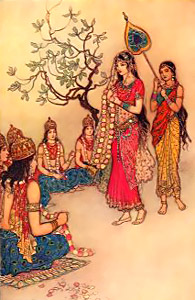 Animisha is one whose eyes do not twinkle and is a term applied to a deity. The gods are said to be devoid of the momentary elevation and depression of the upper eyelid. There are various references of this in poetry. Indra is said to perform Animisha when he visited Sita to encourage her. He treaded the air and suspended the motion of the eyelids at her request.
Animisha is one whose eyes do not twinkle and is a term applied to a deity. The gods are said to be devoid of the momentary elevation and depression of the upper eyelid. There are various references of this in poetry. Indra is said to perform Animisha when he visited Sita to encourage her. He treaded the air and suspended the motion of the eyelids at her request.
It is said that during the marriage of Damayanti, Agni, Varuna, and Indra assumed the form of Nala, her mortal lover Nala. But, then she distinguished her lover by the twinkling of his eyes whilst the gods are `Stabdhalochana` i, e, fixed-eyed. The same trick was applied upon the bride of Chyavana by the Aswini Kumdras. At that time also, she identified he husband through some other indications of Animisha.




















